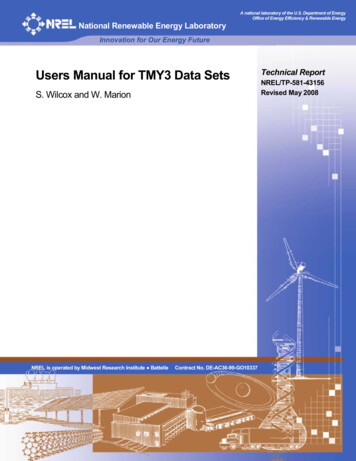
Transcription
A national laboratory of the U.S. Department of EnergyOffice of Energy Efficiency & Renewable EnergyNational Renewable Energy LaboratoryInnovation for Our Energy FutureUsers Manual for TMY3 Data SetsS. Wilcox and W. MarionNREL is operated by Midwest Research Institute BattelleContract No. DE-AC36-99-GO10337Technical ReportNREL/TP-581-43156Revised May 2008
Users Manual for TMY3 Data SetsS. Wilcox and W. MarionPrepared under Task No. PVA7.6101National Renewable Energy Laboratory1617 Cole Boulevard, Golden, Colorado 80401-3393303-275-3000 www.nrel.govOperated for the U.S. Department of EnergyOffice of Energy Efficiency and Renewable Energyby Midwest Research Institute BattelleContract No. DE-AC36-99-GO10337Technical ReportNREL/TP-581-43156Revised May 2008
NOTICEThis report was prepared as an account of work sponsored by an agency of the United States government.Neither the United States government nor any agency thereof, nor any of their employees, makes anywarranty, express or implied, or assumes any legal liability or responsibility for the accuracy, completeness, orusefulness of any information, apparatus, product, or process disclosed, or represents that its use would notinfringe privately owned rights. Reference herein to any specific commercial product, process, or service bytrade name, trademark, manufacturer, or otherwise does not necessarily constitute or imply its endorsement,recommendation, or favoring by the United States government or any agency thereof. The views andopinions of authors expressed herein do not necessarily state or reflect those of the United Statesgovernment or any agency thereof.Available electronically at http://www.osti.gov/bridgeAvailable for a processing fee to U.S. Department of Energyand its contractors, in paper, from:U.S. Department of EnergyOffice of Scientific and Technical InformationP.O. Box 62Oak Ridge, TN 37831-0062phone: 865.576.8401fax: 865.576.5728email: mailto:reports@adonis.osti.govAvailable for sale to the public, in paper, from:U.S. Department of CommerceNational Technical Information Service5285 Port Royal RoadSpringfield, VA 22161phone: 800.553.6847fax: 703.605.6900email: orders@ntis.fedworld.govonline ordering: http://www.ntis.gov/ordering.htmPrinted on paper containing at least 50% wastepaper, including 20% postconsumer waste
ERRATA SHEETNREL REPORT/PROJECT NUMBER: TP-581-43156TITLE: Users Manual for TMY3 Data SetsAUTHORS: S. Wilcox and W. MarionORIGINAL PUBLICATION DATE: April 2008DATE OF CORRECTIONS: May 2008The following corrections were made to this report:Pages 4-5: Table 1-3, Lines 6, 9, 12, 15, 18, 21, 24 text changesPage 8: Table 1-4 replaced
PrefaceThis user's manual describes typical meteorological year (TMY) data sets derived from the 19912005 National Solar Radiation Data Base (NSRDB) update. These data sets provide greatergeographical coverage than previous TMY sets with 1020 locations in the United States and itsterritories.To distinguish between the old and new data sets, the new TMY data sets are referred to asTMY3. The TMY, TMY2, and TMY3 data sets cannot be used interchangeably because ofdifferences in time (solar versus local), formats, elements, and units. Unless they are revised,computer programs designed for previous TMY data will not work with TMY3 data. TheNational Renewable Energy Laboratory (NREL) provides a software utility that allowsreformatting of the TMY3 data to the TMY2 format.The TMY data sets hold hourly values of solar radiation and meteorological elements for a 1year period. Their intended use is for computer simulations of solar energy conversion systemsand building systems to facilitate performance comparisons of different system types,configurations, and locations in the United States and its territories. Because they representtypical rather than extreme conditions, they are not suited for designing systems to meet theworst-case conditions occurring at a location.The TMY3 data sets and this manual were produced by NREL's Electric and Systems Centerunder the Solar Resource Characterization Project, which is funded and monitored by the U.S.Department of Energy's Energy Efficiency and Renewable Energy Office.AcknowledgementsThe meteorological data used in this data set are provided by the National Climatic Data Center(NCDC) from its Integrated Surface Database (ISD). NREL gratefully acknowledges thecountless hours of time and expertise that went into the creation and maintenance of the ISD.More information on the ISD and NCDC is available at http://ncdc.noaa.gov.We also acknowledge the valuable contributions of the Atmospheric Sciences Research Center(ASRC), State University of New York at Albany. The ASRC team provided much of themodeled solar radiation data in this data set using the SUNY satellite model.iii
Table of ContentsPreface. iiiAcknowledgements. iiiList of Figures . ivList of Tables . v1Description of the TMY3 Data Set . 11.1Introduction. 11.2Acquiring TMY3 Data. 11.3Source Data for the TMY3 Data Set. 11.4TMY3 Data Format. 31.5TMY3 Site Selection. 92Procedures for Developing TMY3. 112.1Sandia Method . 112.2Weighting and Index Modifications for TMY2 and TMY3 . 132.3Changes from TMY2 to TMY3 . 142.4El Chichón and Mount Pinatubo Years . 142.5Leap Years . 142.6Month Interface Smoothing . 152.7Allowance for Missing Data . 152.8TMY3 Process Development and Quality Control. 152.9Calculation of Illuminance Data . 192.10 Assignment of Source and Uncertainty Flags. 193References. 21Appendix A – TMY3 Stations . 23List of FiguresFigure 2-1. Cumulative distribution functions for June global horizontal solar radiation forBoulder, Colorado (example from TMY2 processing). 12Figure 2-2. Direct normal delta mean (new minus original 1961–1990) for each evaluationstation. 16Figure 2-3. Year selection frequency comparison between original 1961–1990 and re-created1961–1990 TMYs. . 17Figure 2-4. Year selection frequency for 30-year 1976–2005 TMY. . 18Figure 2-5. Year selection frequency for 15-year 1991–2005 TMY. . 19iv
List of TablesTable 1-1. TMY3 data header (line 1) . 3Table 1-2. TMY3 data header (line 2) . 3Table 1-3. TMY3 data fields (lines 3-8762) . 4Table 1-4. Solar radiation and illuminance source flags. 8Table 1-5. Meteorological source flags . 8Table 1-6. Meteorological uncertainty flags. 8Table 2-1. Weighting values for FS statistics . 13Table 2-2. Bias (test data minus original 61-90 TMY). 17Table 2-3. Standard deviations . 17AcronymsASHRAEAmerican Society of Heating, Refrigerating, and Air-Conditioning EngineersTMYtypical meteorological yearNRELNational Renewable Energy LaboratoryNSRDBNational Solar Radiation Data BaseCSVcomma separated valueCDFcumulative distribution functionsFSFinkelstein- SchaferWSweighted sumv
1 Description of the TMY3 Data SetThis manual describes how to obtain and interpret the data in the Typical Meteorological Year,version 3 (TMY3) data sets. These data sets are an update to, and expansion of, the TMY2 datareleased by the National Renewable Energy Laboratory (NREL) in 1994.1.1 IntroductionA typical meteorological year (TMY) data set provides designers and other users with areasonably sized annual data set that holds hourly meteorological values that typify conditions ata specific location over a longer period of time, such as 30 years. TMY data sets are widely usedby building designers and others for modeling renewable energy conversion systems. Althoughnot designed to provide meteorological extremes, TMY data have natural diurnal and seasonalvariations and represent a year of typical climatic conditions for a location. The TMY should notbe used to predict weather for a particular period of time, nor is it an appropriate basis forevaluating real-time energy production or efficiencies for building design applications or solarconversion systems.Important note: Some of the meteorological data in this data set have been filled. The data-fillingprocess was designed to provide serially complete records as input for modeling the solarradiation fields. Filled meteorological data fields (which are flagged in the data file) may also beuseful for certain renewable energy applications. However, the filled data are not suitable forclimatological studies.The TMY data set is composed of 12 typical meteorological months (January throughDecember) that are concatenated essentially without modification to form a single year with aserially complete data record for primary measurements. These monthly data sets contain actualtime-series meteorological measurements and modeled solar values, although some hourlyrecords may contain filled or interpolated data for periods when original observations aremissing from the data archive.1.2 Acquiring TMY3 DataThe TMY3 data are available for download via the World Wide Web. Data may be accessed athttp://rredc.nrel.gov/solar/old data/nsrdb/1991-2005/tmy3.1.3 Source Data for the TMY3 Data SetThe first TMY data set for the United States was produced by Sandia National Laboratories in1978 for 248 locations using long-term weather and solar data from the 1952–1975SOLMET/ERSATZ database (Hall et al. 1978). NREL updated the TMY data in 1994 using datafrom the 30-year 1961–1990 National Solar Radiation Data Base (NSRDB) (Marion, et al.1995). In 2007, NREL released a 15-year updated NSRDB for 1991–2005 (Wilcox et al. 2007a).The TMY3 data described here were produced using input data for 1976-2005 from the 19611990 NSRDB, Version 1.1 and the 1991-2005 NSRDB update.Because the 1961-1990 NSRDB has 239 sites and the 1991-2005 NSRDB update has more than1,400 sites, production of the TMY3 data was designed to maximize both the number of stations1
and the number of years from which to characterize the typical conditions. At sites where dataare available for 30 years, the base time period for the TMY algorithm spans 1976-2005. For theremaining sites, the base time period spans 1991-2005. These two categories of sites aredocumented in Appendix A.In the creation of a TMY, selecting from a larger database generally affords smaller differencesbetween selected data months and long-term monthly characteristics. Conversely, the smaller thepool of years from which to determine climate characteristics, the less likely the selectionrepresents the climate (ASHRAE 2004). In the same context, the eruptions of El Chichón in1982 and Mt. Pinatubo in 1991 had significant effects on solar radiation for the United States andfurther reduced the pool of data for determining the typical climate. Volcanic eruptions, whileoften significantly diminishing solar energy at the earth’s surface, are rare, unpredictable, andvariable in intensity. Designers may want to know the potential effects of volcanic eruptions todetermine worst-case scenarios, but such perturbations do not contribute to long-term climatecharacterization.Except for a few changes to the weighting criteria, which account for the relative importance ofthe solar radiation and meteorological elements, the TMY2 and TMY3 data sets were createdusing procedures similar to those developed by Sandia National Laboratories (Hall et al. 1978) tocreate the original TMYs from the 1952-1975 SOLMET/ERSATZ data (see Section 2.1). Minorchanges to the algorithm were made between the TMY2 and TMY3 production runs (see Section2.3). A small change to the persistence criteria better accommodates selecting a TMY month forperiods or records with fewer years. Also, computer code was removed that prioritized theselection of months with measured solar data because no measured data were used in the 19912005 NSRDB update. The effects of these changes between the TMY2 and TMY3 algorithmwere evaluated as part of the TMY3 production process (see Section 2.8). In the context ofproducing data sets with similar characteristics, these effects were small (Wilcox, et al. 2008).The Sandia method is an empirical approach that selects individual months from different yearsoccurring in the period of record. For example, in the case of the NSRDB that contains 30 yearsof data, all 30 Januarys are examined, and the one judged most typical by the TMY algorithm isselected to be included in the TMY. The other months of the year are treated in a like manner,and then the 12 selected typical months are concatenated to form a complete year.The 12 selected typical months for each station were chosen using statistics determined byconsidering five elements: global horizontal radiation, direct normal radiation, dry bulbtemperature, dew point temperature, and wind speed. These elements are considered the mostimportant for simulating solar energy conversion systems and building systems.Because the TMY algorithm assigns priority to the solar radiation elements, the selected monthsmay or may not be typical for other elements. Cloud cover, which correlates well with solarradiation, is probably reasonably typical. Other elements are not related to the elements used forselection; consequently, their values may not be typical. Additionally, even though wind speedwas used in the selection of the typical months, its relatively low weighting with respect to theother elements prevents it from being sufficiently typical for simulating wind energy conversionsystems.2
1.4 TMY3 Data FormatThe format for the TMY3 data is radically different from the TMY and TMY2 data. The olderTMY data sets used columnar or positional formats, presumably as a method of optimizing datastorage space. Such formats are difficult to read, and it is difficult to import specific fields intomany software packages.The comma separated value (CSV) format is ubiquitous, and many existing programs andapplications provide built-in functions to read or parse it. For that reason, the TMY3 data set isdistributed in the CSV format. For compatibility with existing software, NREL has produced anapplication to convert from TMY3 to TMY2 format.Despite the format differences, the fields in the TMY3 are very similar to those in the TMY2data set. Fundamental differences are measurement units, which are SI or equivalent in theTMY3, the addition of three new fields for surface albedo and liquid precipitation, and theremoval of the fields for present weather, snow-depth, and days since last snowfall that werepresent in the TMY2. These fields were removed because of incompatible changes in the natureof the source data or because the source data were not available. The TMY3 data files are namedaccording to the USAF site identifier as 999999TY.CSV, where 999999 represents the six digitUSAF station identifier (see Appendix A). The TMY3 data format has two file header lines and8,760 lines of data, each with 68 data fields. The format is documented in Tables 1-1 to 1-3.Table 1-1. TMY3 data header (line 1)Field1234567ElementUnit or DescriptionUSAF numberQuote delimitedTwo-letter U.S. Postal abbreviationHours from Greenwich, negative westDecimal degreeDecimal degreeMeterSite identifier codeStation nameStation stateSite time zoneSite latitudeSite longitudeSite elevationTable 1-2. TMY3 data header (line 2)Field1-68ElementData field name and units (abbreviation or mnemonic)3
Table 1-3. TMY3 data fields (lines 3-8762)Field12ElementDateTimeUnit or strialradiation on ahorizontal surfaceWatt-hour persquare meter1 Wh/m24Hourlyextraterrestrialradiation normal tothe sunWatt-hour persquare meter1 Wh/m25Global horizontalirradianceWatt-hour persquare meter1 Wh/m26Global horizontalirradiance sourceflagGlobal ct normalirradianceWatt-hour persquare meter1 Wh/m9Direct normalirradiance sourceflagDirect use horizontalirradianceWatt-hour persquare meter1 Wh/m12Diffuse horizontalirradiance sourceflagDiffuse DescriptionDate of data recordTime of data record (localstandard time)Amount of solar radiationreceived on a horizontal surfaceat the top of the atmosphereduring the 60-minute periodending at the timestampAmount of solar radiationreceived on a surface normal tothe sun at the top of theatmosphere during the 60minute period ending at thetimestampTotal amount of direct anddiffuse solar radiation receivedon a horizontal surface duringthe 60-minute period ending atthe timestampSee Table 1-4Uncertainty based on randomand bias error estimates – seeNSRDB User’s Manual (Wilcox,2007b)Amount of solar radiation(modeled) received in acollimated beam on a surfacenormal to the sun during the 60minute period ending at thetimestampSee table 1-4Uncertainty based on randomand bias error estimates – seeNSRDB User’s Manual (Wilcox,2007b)Amount of solar radiationreceived from the sky (excludingthe solar disk) on a horizontalsurface during the 60-minuteperiod ending at the timestampSee Table 1-4Uncertainty based on randomand bias error estimates – seeNSRDB User’s Manual (Wilcox,2007b)
14Global horizontalilluminanceLux100 lx15Global horizontalilluminance sourceflagGlobal horizontalilluminanceuncertaintyDirect normalilluminance1-2--Percent1%Lux100 lxDirect normalilluminance sourceflagDirect normalilluminanceuncertaintyDiffuse horizontalilluminance1-2--Percent1%Lux100 lxDiffuse horizontalilluminance sourceflagDiffuse horizontalilluminanceuncertaintyZenith luminance1-2--Percent1%Candela persquare meter10 cd/mZenith luminancesource flagZenith luminanceuncertainty1-2--Percent1%26Total sky coverTenths of sky1 tenth27Total sky cover flag(source)Total sky cover flag(uncertainty)Opaque sky cover161718192021222324252829Average total amount of directand diffuse illuminance receivedon a horizontal surface duringthe 60-minute period ending atthe timestampSee Table 1-4Uncertainty based on randomand bias error estimates – seesection 2.10)Average amount of directnormal illuminance receivedwithin a 5.7 field of viewcentered on the sun during 60minute period ending at thetimestampSee Table 1-4Uncertainty based on randomand bias error estimates – seesection 2.10)Average amount of illuminancereceived from the sky (excludingthe solar disk) on a horizontalsurface during the 60-minuteperiod ending at the timestampSee Table 1-42Uncertainty based on randomand bias error estimates – seesection 2.10)Average amount of luminance atthe sky's zenith during the 60minute period ending at thetimestampSee Table 1-4Uncertainty based on randomand bias error estimates – seesection 2.10)Amount of sky dome covered byclouds or obscuring phenomenaat the time indicatedSee Table 1-5See Table 1-6Tenths of sky1 tenth5Amount of sky dome covered byclouds or obscuring phenomenathat prevent observing the skyor higher cloud layers at thetime indicated
ue sky coverflag (source)Opaque sky coverflag e flag(source)Dry-bulbtemperature erature flag(source)Dew-pointtemperature flag(uncertainty)Relative humidityRelative humidityflag (source)Relative humidityflag (uncertainty)Station pressureStation pressure flag(source)Station pressure flag(uncertainty)Wind directionWind direction flag(source)Wind direction flag(uncertainty)Wind speedWind speed flag(source)Wind speed flag(uncertainty)Horizontal visibilitySee Table 1-5See Table 1-6Degree C0.1 Dry-bulb temperature at the timeindicatedSee Table 1-5See Table 1-6Degree C0.1 Dew-point temperature at thetime indicatedSee Table 1-5See Table 1-6Percent1%Relative humidity at the timeindicatedSee Table 1-5See Table 1-6Millibar1 mbarStation pressure at the timeindicatedSee Table 1-5See Table 1-6Degrees fromnorth (360 north; 0 undefined,calm)10 Wind direction at the timeindicatedSee Table 1-5See Table 1-6Meter/second0.1 m/sWind speed at the timeindicatedSee Table 1-5See Table 1-6Meter*1mHorizontal visibilityflag (source)Horizontal visibilityflag (uncertainty)6Distance to discernable remoteobjects at the time indicated(7777 unlimited)See Table 1-5
53Ceiling height54Ceiling height flag(source)Ceiling height flag(uncertainty)Precipitable water5556575859606162636465Precipitable waterflag (source)Precipitable waterflag (uncertainty)Aerosol opticaldepth, broadbandAerosol opticaldepth, broadbandflag (source)Aerosol opticaldepth, broadbandflag (uncertainty)AlbedoAlbedo flag (source)Albedo flag(uncertainty)Liquid precipitationdepth66Liquid precipitationquantity67Liquid precipitationdepth flag (source)Liquid precipitationdepth flag(uncertainty)68Meter*1mHeight of the cloud base abovelocal terrain (77777 unlimited)See Table 1-5See Table 1-6Centimeter0.1 cmThe total precipitable watercontained in a column of unitcross section extending from theearth's surface to the top of theatmosphereSee Table 1-5See Table 1-6[unitless]0.001The broadband aerosol opticaldepth per unit of air mass due toextinction by the aerosolcomponent of the atmosphereSee Table 1-5See Table 1-6[unitless]0.01The ratio of reflected solarirradiance to global horizontalirradianceSee Table 1-5See Table 1-6Millimeter*1 mmHour*1 hrThe amount of liquidprecipitation observed at theindicated time for the periodindicated in the liquidprecipitation quantity fieldThe period of accumulation forthe liquid precipitation depthfieldSee Table 1-5See Table 1-6*Value of -9900 indicates the measurement is missing.7
Table 1-4. Solar radiation and illuminance source flagsFlagDefinition1Data modeled using METSTAT or from 1961-1990 NSRDB solar fields2Data modeled using SUNY Satellite model (time shifted)Table 1-5. Meteorological source flagsFlagDefinitionAData as received from NCDC, converted to SI unitsBLinearly interpolatedCNon-linearly interpolated to fill data gaps from 6 to 47 hours in lengthDNot usedEModeled or estimated, except: precipitable water, calculated from radiosonde data; dew pointtemperature calculated from dry bulb temperature and relative humidity; and relative humiditycalculated from dry bulb temperature and dew point temperatureFPrecipitable water, calculated from surface vapor pressure; aerosol optical depth, estimated fromgeographic correlation?Source does not fit any of the above. Used mostly for missing dataTable 1-6. Meteorological uncertainty flagsFlagDefinition1–6Not used7Uncertainty consistent with NWS practices and the instrument or observationused to obtain the data8Greater uncertainty than 7 because values were interpolated or estimated9Greater uncertainty than 8 or unknown0Not definable8
1.5 TMY3 Site SelectionWhile planning the TMY3 update project, we considered two possible scenarios for populatingthe data set: Create a TMY based on the 30 most recent years of data (1976–2005) for only the 239 sitescommon to both the old NSRDB and the NSRDB update Create a TMY based on the 15 most recent years of data (1991–2005) for approximately 950sites from the NSRDB update.To optimize both temporal and spatial considerations, the TMY3 combines these scenarios sothat the 30-year data were used at sites where they were available and the 15-year data were usedfor the remaining sites. The TMY3 sites are listed in Appendix A. The sites in the 1991-2005NSRDB were chosen based on data availability rather than geographic location (all sites meetingminimum data criteria were included). For this reason, in the both the NSRDB update and theTMY3, sites may occur in close proximity, for example in major metropolitan areas.The period of record of the source data set has an effect on the ability of the TMY algorithm toselect a typical year (ASHRAE 2004). Because of differences in the source period of record forsites, this information has been documented in Appendix A. See Section 2.8 for a discussion ofthe effect of available data on the TMY statistics. Note that for the 30-year period, the pool isreduced to 24 years at best because of the removal of candidate years due to volcanic eruptions(see Section 2.4). For the 15-year period, the pool is reduced to 12 years at best for the samereason. Although some studies have shown than as few as five years may suffice for capturingmuch of the statistical character of a climate (Vignola 1993), we implemented a moreconservative constraint on the size of the source data pool: No stations with less than a ten-yeardata pool were included in the TMY3 data set.The NSRDB update subdivided stations by class: Class I sites are those with the lowestuncertainty data, Class II sites have higher uncertainty data, and Class III sites have anincomplete period of record. When creating TMY data sets, we did not consider the class of thesite or the uncertainty of the source data. Further, although Class III sites have gaps in the data,the TMY algorithm was able to produce a typical year for many Class III sites using months ofdata without gaps. To aid users in analyzing the quality of the data, we have included thestation’s quality classification from the NSRDB update in Appendix A . The NSRDBclassification subdivided stations according to the following algorithm: If any data were missing from the key fields (solar, temperature, humidity, stationpressure, wind speed, aerosols, and precipitable water), the station received a Class IIIdesignation. The algorithm distinguishes between Class I and Class II stations byexamining the uncertainty for each hourly modeled value in the global field. If less than25% of the data for the 15-year period of record exceeds an uncertainty of 11%, thestation received a Class I designation. Otherwise, it received a Class II designation.Although the 11% threshold between high and low uncertainty may seem arbitrary, basedon the uncertainty calculations in the NSRDB update, this value easily discriminatesbetween the data modeled with good human-observed or satellite-derived cloud coverand the filled or statistically derived cloud cover.9
Although the TMY data set likely does not have the same distribution of quality flags for astation as the entire period of record (it could be better or worse), the NSRDB classificationscheme is valid for estimating the quality of a station’s TMY. This follows because the NSRDBclassification is relevant to the quality of the long-term statistics used to choose the data thatultimately represent the site’s climate in the TMY. Although the Class III designation focused ondata completeness rather than data quality, the data from most Class III stations were similar inquality to those of Class II stations and should be considered comparable when considering dataquality in the TMY3 data set.The geographical coordinates listed in Appendix A may not exactly correspond with thecoordinates of the meteorologic
These data sets are an update to, and expansion of, the TMY2 data released by the National Renewable Energy Laboratory (NREL) in 1994. 1.1 Introduction A typical meteorological year (TMY) data set provides designers and other users with a reasonably sized annual data set that hol










